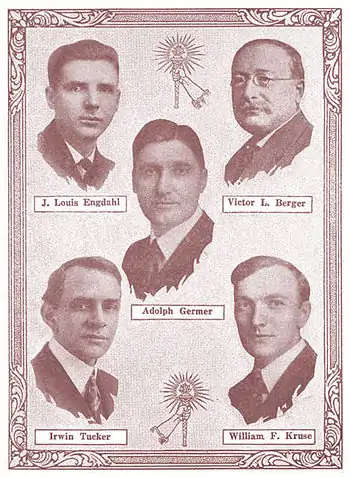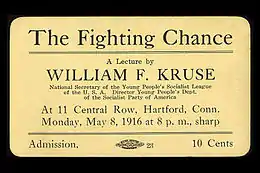William F. Kruse
William F. "Bill" Kruse (1894–1979) was an important head of the Young People's Socialist League (YPSL) in the 1910s. He was a member of the Socialist Party of America until 1921, acting as a leader of the party's Left Wing faction, loyal to the Third International (Comintern). Thereafter he joined the Workers Party of America, serving as Assistant Executive Secretary of the WPA from the time of its foundation in December 1921.

Biography
Early years
William F. "Bill" Kruse was born in Hoboken, New Jersey to German and Danish immigrant parents in 1894.
Kruse worked briefly as a sheet metal worker in his youth. He later studied at the Socialist Party of America's Rand School of Social Science under Algernon Lee.
Political career
In July 1915, the governing National Executive Committee of the SPA appointed the 21-year-old as Director of the party's youth section, the Young People's Socialist League (YPSL).[1] Kruse served two terms in this position, finishing in June 1918.[1] He also served as editor of the YPSL's national publication, Young Socialists' Magazine, from 1918 to 1919 and as the Provisional Secretary of the SPA's national Socialist Sunday School movement.
Kruse was the fraternal delegate of the YPSL to the party's seminal 1917 Emergency National Convention in St. Louis. Militantly opposed to the war in Europe, Kruse, a law school graduate, worked to defend the civil rights of war opponents as a leader of the American Liberty Defense League.
As head of the Socialist Party's youth organization and a vociferous critic of American participation in the war, Kruse was targeted by the US Department of Justice headed by Attorney General A. Mitchell Palmer under the Espionage Act. Kruse was indicted in Chicago by a grand jury on Feb. 2, 1918, and the secret indictment was made public on March 9. The sensational and widely publicized trial of Kruse and 4 other top members of the Socialist Party began before Judge Kenesaw Mountain Landis on Dec. 6, 1918. This trial ended Jan. 4, 1919, with the jury finding Kruse and his associates (Victor L. Berger, Adolph Germer, J. Louis Engdahl, Irwin St. John Tucker) guilty. Landis sentenced each to 20 years in the Federal penitentiary, a sentence which was appealed and later overturned on the basis of judicial bias.

Released on bond, Kruse continued as a Contributing Editor of Young Socialists' Magazine from March 1919. He was a delegate to the 1919 Emergency National Convention of the SPA in August 1919,[2] representing a Left Wing voice on the floor, but refusing to bolt the convention to join the Communist Labor Party of America gathering downstairs. Kruse was elected to serve on a new party institution to oversee controversial personnel decisions of the NEC, the Board of Appeals, and he continued in this role on this largely unused body until 1920. In September 1919, with the YPSL moving to organizational independence under its Secretary, Oliver Carlson, Kruse was named head of the SPA's new "Young People's Department." He also resumed editorship of Young Socialists' Magazine, now back under party control. Kruse also worked as a National Organizer for the SPA, rebuilding the Rhode Island state organization, among other tasks.
Kruse was a Socialist candidate for the US House of Representatives from the Illinois 6th C.D. in 1918 and again 1920, and for Illinois Secretary of State in 1921.[3]
Kruse remained active in the Left Wing movement inside the SPA until the fall of 1921, organizing the Committee for the Third International with his associates Louis Engdahl and Alexander Trachtenberg. After the triumph of the party's Regulars at the 1921 Convention, Kruse, Engdahl, and their associates left the party, advocating for an "open" Communist Party in the United States. This desire came to fruition in December 1921 with the establishment of the Workers Party of America, in which Kruse served as the Assistant Executive Secretary from the time of its foundation. He was also elected by the founding convention of the WPA as an Alternate to the WPA's governing Central Executive Committee. On June 29, 1929, Kruse was promoted to full member of the CEC of the WPA when Marguerite Prevey resigned.
Kruse was an adherent of the Pepper-Ruthenberg-Lovestone faction throughout the Communist Party's factional struggles of the 1920s.
From 1926 to 1927, Kruse was among the first Americans to study at the Comintern's Lenin School in Moscow, where he also served in an informal capacity as a lieutenant of the Lovestone faction in the USSR.[4] Upon his return in 1927, Kruse was appointed by the CEC as District Organizer of the Communist Party's important Chicago district.
In 1928 Kruse stood as the candidate for Governor of Illinois of the Workers (Communist) Party.[5]
Kruse was expelled from the Communist (Workers) Party in 1929 for refusing to denounce party leader Jay Lovestone. He left radical politics and became Educational Director for Bell and Howell Films, later opening his own public relations firm in Chicago, William F. Kruse & Associates.
Kruse and Instructional Technology
Kruse worked for Bell and Howell for 17 years heading up several departments.[6] He was an advertising representative for Educational Screen and Audiovisual Guide for a number of years and was appointed archivist of the DAVI in 1955 [7] where he ended up holding many roles in the Department of Audio Visual Instruction.
Kruse went to great lengths to ensure the field of Instructional Design and Technology (IDT) had an archive for future research and much of the Association for Educational Communication and Technology (AECT) archive in Hornbake Library at the University of Maryland is the result of his efforts. For example, the first three boxes in the archive contain correspondence by Kruse in his attempt to find materials for the archive, Kruse's sources for his unpublished manuscript on the history of the field and numerous photographic collections by Kruse related to the history of IDT.
The AECT archive at the University of Maryland contains a copy of Kruse's unpublished book, The Projected Image.[8] A portion of this book was published in The Journal of Society of Motion Picture and Television Engineers under the title Willard Beach Cook-Pioneer Distributor of Narrow-Gage Safety Films and Equipment.[9] The unpublished book is 430 pages long, is heavily marked with notes and editing lines, and contains a mix of educational and industry observations. The preface states: The Story of the development of the projected image as a means of communication involves such a close and constant interrelationship of education and of industry that its telling is materially enriched by the authoritative dual viewpoint that Mr. Kruse is uniquely qualified to give.
Kruse was outspoken and a strong proponent for the use of audio-visual communication. In his introduction he stated: It is high time, too, that the audio-visual specialist refuses to be looked down on as a Johnny-come-lately upstart. The roots of his professional family tree run deeper than those of the verbalist critic. That audio-visual education is at once the newest and the oldest form of learning known to the human race is the point of our first chapter.
Though Kruse did not directly write about the goals of his study, the first two chapters of his book were written to show that it was the audio-visual specialist who, "raised teaching to the level of learned profession, who gave new vistas to the science of psychology and who supplied the basis for new humane philosophical trends" . Kruse wrote that his manuscript was for the, "audio-visual specialist, the teacher, the audio-visual industry worker, the person with a story to tell and lastly, all of us, citizens, as fellow-men" . He was clear that he wanted to show in his history that, "The audio-visual process- which integrates a learner's sensory experience with his apperceptional reservoir and thus fits him for better living in his society- is education".
Death and legacy
Bill Kruse died in 1979. The William F. Kruse papers are housed at the Hoover Institution at Stanford University in Palo Alto, California, the Abraham Lincoln Presidential Library, as well as the Chicago Historical Society.
Footnotes
- "Young People's Socialist League: Organizational History," Early American Marxism website, marxisthistory.org/
- "Delegates to the 1919 Emergency Convention of the Socialist Party of America," Marxists Internet Archive, marxists.org/
- Lawrence Kestenbaum (ed.), "William F. Kruse," The Political Graveyard, politicalgraveyard.com/ Retrieved June 2, 2011.
- Benjamin Gitlow, I Confess: The Truth About American Communism. New York: E.P. Dutton, 1940; pg. 425.
- "Kruse to Tour South Illiniois," Daily Worker, vol. 5, no. 238 (October 8, 1928), pg. 1.
- Ross, S. J. (1999). Working-class Hollywood: Silent film and the shaping of class in America. Princeton, NJ: Princeton University Press.
- Lembo, D.L. (1970). A History of the growth and development of the DAVI/NEA from 1923 to 1968 (Doctoral dissertation). New York University, New York, NY.
- Kruse, W.F. (n.d.). The projected image: A history of audio-visual education. Association of Educational Communications and Technologies Archive, Box 26. College Park, MD.
- Kruse, W.F. (1964). Willard Beach Cook — Pioneer distributor of narrow-gage safety films and equipment. Journal of the Society of Motion Picture & Television Engineers, 73 (7), 576-579.
Works
- In the United States Circuit Court of Appeals for the Seventh Circuit. October term, A.D. 1918. Victor L. Berger, Adolph Germer, William F. Kruse, Irwin St. John Tucker and J. Louis Engdahl, plaintiffs in error, vs. United States of America, defendant in error. Error to the District Court of the United States for the Northern District of Illinois, Eastern Division, K.M. Landis, Judge ... Brief for the plaintiffs in error. With Messrs. Berger, Germer, Tucker, and Engdahl. Chicago: The Court, 1919.
- 100 years — For What? Being the Addresses of Victor L. Berger, Adolph Germer, J. Louis Engdahl, William F. Kruse and Irwin St. John Tucker to the Court that Sentenced Them to Serve 100 years in Prison. With Messrs. Berger, Germer, Tucker, and Engdahl. Chicago: National Office, Socialist Party, n.d. [1919].
- "Socialists, Prepare!" The Socialist World (Chicago), vol. 1, no. 5 (November 15, 1920), pp. 4–5.